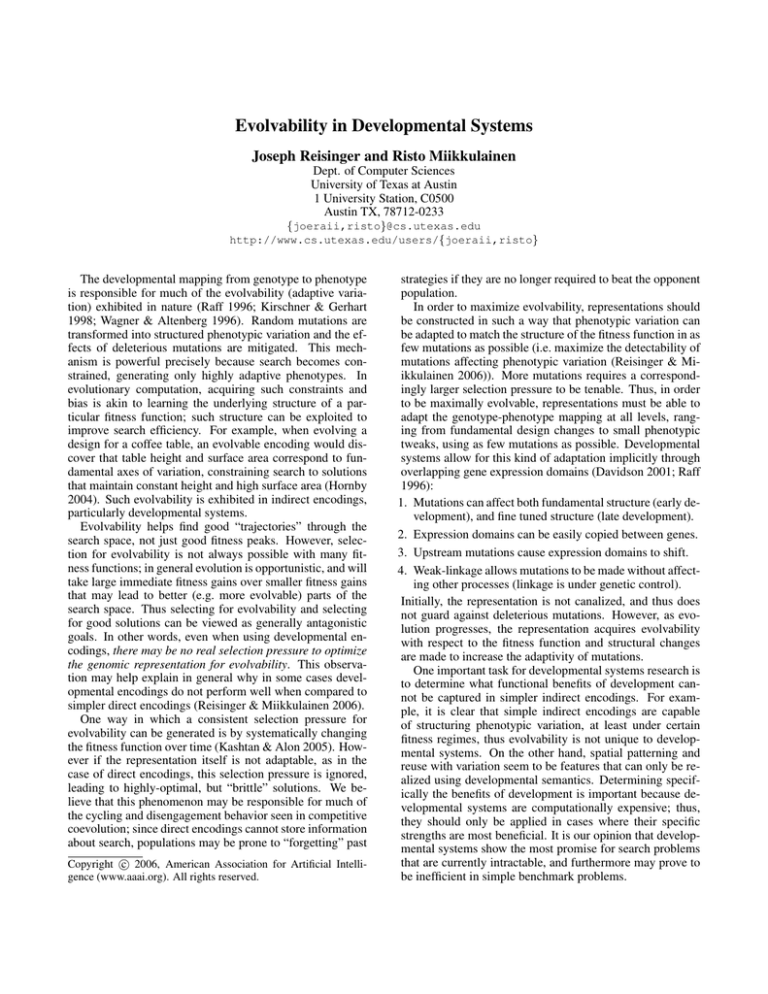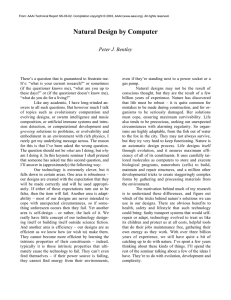
Evolvability in Developmental Systems
Joseph Reisinger and Risto Miikkulainen
Dept. of Computer Sciences
University of Texas at Austin
1 University Station, C0500
Austin TX, 78712-0233
{joeraii,risto}@cs.utexas.edu
http://www.cs.utexas.edu/users/{joeraii,risto}
The developmental mapping from genotype to phenotype
is responsible for much of the evolvability (adaptive variation) exhibited in nature (Raff 1996; Kirschner & Gerhart
1998; Wagner & Altenberg 1996). Random mutations are
transformed into structured phenotypic variation and the effects of deleterious mutations are mitigated. This mechanism is powerful precisely because search becomes constrained, generating only highly adaptive phenotypes. In
evolutionary computation, acquiring such constraints and
bias is akin to learning the underlying structure of a particular fitness function; such structure can be exploited to
improve search efficiency. For example, when evolving a
design for a coffee table, an evolvable encoding would discover that table height and surface area correspond to fundamental axes of variation, constraining search to solutions
that maintain constant height and high surface area (Hornby
2004). Such evolvability is exhibited in indirect encodings,
particularly developmental systems.
Evolvability helps find good “trajectories” through the
search space, not just good fitness peaks. However, selection for evolvability is not always possible with many fitness functions; in general evolution is opportunistic, and will
take large immediate fitness gains over smaller fitness gains
that may lead to better (e.g. more evolvable) parts of the
search space. Thus selecting for evolvability and selecting
for good solutions can be viewed as generally antagonistic
goals. In other words, even when using developmental encodings, there may be no real selection pressure to optimize
the genomic representation for evolvability. This observation may help explain in general why in some cases developmental encodings do not perform well when compared to
simpler direct encodings (Reisinger & Miikkulainen 2006).
One way in which a consistent selection pressure for
evolvability can be generated is by systematically changing
the fitness function over time (Kashtan & Alon 2005). However if the representation itself is not adaptable, as in the
case of direct encodings, this selection pressure is ignored,
leading to highly-optimal, but “brittle” solutions. We believe that this phenomenon may be responsible for much of
the cycling and disengagement behavior seen in competitive
coevolution; since direct encodings cannot store information
about search, populations may be prone to “forgetting” past
c 2006, American Association for Artificial IntelliCopyright gence (www.aaai.org). All rights reserved.
strategies if they are no longer required to beat the opponent
population.
In order to maximize evolvability, representations should
be constructed in such a way that phenotypic variation can
be adapted to match the structure of the fitness function in as
few mutations as possible (i.e. maximize the detectability of
mutations affecting phenotypic variation (Reisinger & Miikkulainen 2006)). More mutations requires a correspondingly larger selection pressure to be tenable. Thus, in order
to be maximally evolvable, representations must be able to
adapt the genotype-phenotype mapping at all levels, ranging from fundamental design changes to small phenotypic
tweaks, using as few mutations as possible. Developmental
systems allow for this kind of adaptation implicitly through
overlapping gene expression domains (Davidson 2001; Raff
1996):
1. Mutations can affect both fundamental structure (early development), and fine tuned structure (late development).
2. Expression domains can be easily copied between genes.
3. Upstream mutations cause expression domains to shift.
4. Weak-linkage allows mutations to be made without affecting other processes (linkage is under genetic control).
Initially, the representation is not canalized, and thus does
not guard against deleterious mutations. However, as evolution progresses, the representation acquires evolvability
with respect to the fitness function and structural changes
are made to increase the adaptivity of mutations.
One important task for developmental systems research is
to determine what functional benefits of development cannot be captured in simpler indirect encodings. For example, it is clear that simple indirect encodings are capable
of structuring phenotypic variation, at least under certain
fitness regimes, thus evolvability is not unique to developmental systems. On the other hand, spatial patterning and
reuse with variation seem to be features that can only be realized using developmental semantics. Determining specifically the benefits of development is important because developmental systems are computationally expensive; thus,
they should only be applied in cases where their specific
strengths are most beneficial. It is our opinion that developmental systems show the most promise for search problems
that are currently intractable, and furthermore may prove to
be inefficient in simple benchmark problems.
Using a developmental system, search bias can be adapted
over the course of evolution, and therefore such systems can
become more evolvable towards a specific fitness function.
However, they will only do so if there is sufficient selection
pressure. Thus, the interplay between representation and fitness function must be considered when designing evolvable
developmental encodings. We are currently investigating
how developmental systems can be made more evolvable,
focusing in particular on:
1. What mechanisms can ensure selection pressure for
evolvability?
2. How can selection for evolvability be balanced with fast,
exploitative search?
3. In what domains is evolvability necessary?
4. What representational features allow populations to acquire evolvability over time?
5. How can developmental systems be simplified without reducing their overall evolvability?
Ultimately this work will lead to more powerful encodings
capable of solving complex optimization and design problems.
References
Davidson, E. H. 2001. Genomic Regulatory Systems. San
Diego: Academic Press.
Hornby, G. S. 2004. Functional scalability through generative representations: The evolution of table designs. Environment and Planning B: Planning and Design 31(4):569–
587.
Kashtan, N., and Alon, U. 2005. Spontaneous evolution
of modularity and network motifs. Proc. of the National
Academy of Sciences 102(39).
Kirschner, M., and Gerhart, J. 1998. Evolvability. PNAS
95:8420–8427.
Raff, R. A. 1996. The Shape of Life: Genes, development, and the Evolution of Animal Form. The University
of Chicago Press.
Reisinger, J., and Miikkulainen, R. 2006. Selecting for
evolvable representations. In GECCO ’06: Proceedings
of the 2006 Genetic and evolutionary computation conference, 257–264. New York, NY, USA: ACM Press.
Wagner, G., and Altenberg, L. 1996. Complex adaptations
and the evolution of evolvability. Evolution 50(3):967–976.




